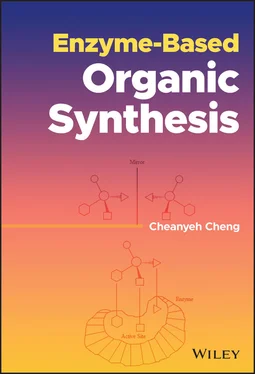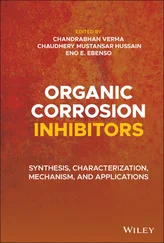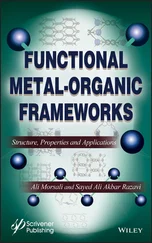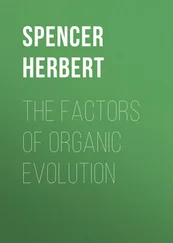Cheanyeh Cheng - Enzyme-Based Organic Synthesis
Здесь есть возможность читать онлайн «Cheanyeh Cheng - Enzyme-Based Organic Synthesis» — ознакомительный отрывок электронной книги совершенно бесплатно, а после прочтения отрывка купить полную версию. В некоторых случаях можно слушать аудио, скачать через торрент в формате fb2 и присутствует краткое содержание. Жанр: unrecognised, на английском языке. Описание произведения, (предисловие) а так же отзывы посетителей доступны на портале библиотеки ЛибКат.
- Название:Enzyme-Based Organic Synthesis
- Автор:
- Жанр:
- Год:неизвестен
- ISBN:нет данных
- Рейтинг книги:3 / 5. Голосов: 1
-
Избранное:Добавить в избранное
- Отзывы:
-
Ваша оценка:
- 60
- 1
- 2
- 3
- 4
- 5
Enzyme-Based Organic Synthesis: краткое содержание, описание и аннотация
Предлагаем к чтению аннотацию, описание, краткое содержание или предисловие (зависит от того, что написал сам автор книги «Enzyme-Based Organic Synthesis»). Если вы не нашли необходимую информацию о книге — напишите в комментариях, мы постараемся отыскать её.
An insightful exploration of an increasingly popular technique in organic chemistry Enzyme-Based Organic Synthesis
Enzyme-Based Organic Synthesis
Enzyme-Based Organic Synthesis
Enzyme-Based Organic Synthesis — читать онлайн ознакомительный отрывок
Ниже представлен текст книги, разбитый по страницам. Система сохранения места последней прочитанной страницы, позволяет с удобством читать онлайн бесплатно книгу «Enzyme-Based Organic Synthesis», без необходимости каждый раз заново искать на чём Вы остановились. Поставьте закладку, и сможете в любой момент перейти на страницу, на которой закончили чтение.
Интервал:
Закладка:
The asymmetric reduction of β‐ketoesters mediated by microorganisms has become a standard method for the synthesis of chiral β‐hydroxyesters [158, 159]. Recently, the immobilization of ADH from permeabilized brewer’s yeast on derived attapulgite nanofibers through glutaraldehyde covalent binding for the bioreduction of ethyl 3‐oxobutyrate (EOB) to ethyl ( S )‐3‐hydroxybutyrate (( S )‐EHB) was investigated. The effect of immobilization on ADH activity for the bioreduction shows that the immobilized ADH retained higher activity over wider ranges of pH and temperature than those of the free enzyme. The optimum temperature and pH of the immobilized ADH were 7.5 and 35 °C, respectively. Under the optimum conditions, the immobilized enzyme retained 58% of the original activity after 32 hours of incubation. The conversion of substrate (EOB) and the enantiomeric excess value of ( S )‐product reached 88 and 99.2%, respectively, within two hours. The immobilized ADH retained about 42% of the initial activity after eight cycles [160]. Also, although the yields and the enantioselectivity are low to moderate, the enantioselective bioreduction of ethyl benzoylacetate and their p ‐nitro and p ‐methoxy substituted derivatives to form corresponding chiral ethyl 3‐hydroxy‐3‐phenylpropionate and substituted derivatives ( Scheme 2.38) has long been of interest in pharmaceutical industry for synthesizing the key chiral building blocks of many compounds such as fluoxetine [161], chloramphenicol [162], and diltiazem [163]. However, the coupling of simple screening procedures and reaction engineering strategy can increase the ( S )‐enantioselectivity to 99% e.e. and shows a significant improvement in the yields to around 85%. In this way, yeasts Pichia kluyveri , Pichia stipites , and Candida utilis were screened and better yields and e.e.’s for ethyl benzoylacetate, p ‐nitrobenzoylacetate, and p ‐methoxybenzoylacetate can be achieved by the addition of glucose, α‐chloroacetophenone as inhibitor, and immobilization of the yeast in alginate beads, respectively. These processes can also be implemented on a preparative scale and still maintain the same yield and e.e. [164].

Scheme 2.38 Yeast mediated enantioselective reduction of ethyl benzoylacetate and substituted derivatives.
Although water is the first choice as solvent for biocatalysis, the low solubility of organic compounds in water, difficult product separation, and potential side reactions caused by other enzymes in the cell have led to alternative solvents being sought. Since optically pure ( S )‐1‐(4′‐methoxyphenyl) ethanol (( S )‐MOPE) is a potential synthon for the preparation of cycloalkyl [b] indoles in clinical treatment of general allergic response, whole microbial cells have been used to synthesize for enantiopure ( S )‐MOPE from 4′‐methoxyacetophenone (MOAP) in aqueous systems [165]. Recently, the bioreduction of MOAP to ( S )‐MOPE has been successfully performed in a hydrophilic ionic liquid (IL) containing cosolvent system using immobilized Rhodotorula sp . AS2.2241 cells. The novel IL 1‐(2′‐hydroxy)ethyl‐3‐methylimidazolium nitrate (C 2OHMIM•NO 3) gave the best results. Under the optimized conditions of pH 8.5, a temperature of 25 °C, and an optimal C 2OHMIM•NO 3content of 5.0% (v/v), 12 mM, the initial reaction rate, the maximum yield, and the product e.e. were 9.8 μmol h –1(g cell) –1, 98.3%, and >99%, respectively. Also, the cells exhibited excellent operational stability with the cosolvent system. Moreover, the established system has been highly efficiently applied for the reduction of many other aryl ketones [166]. Immobilization of whole cell of Geotrichum candidum onto an ion exchange resin with polyallylamine was used for the enantioselective bioreduction of various ketones, such as acetophenone, ortho ‐fluoro and para ‐fluoro acetophenone, ortho ‐methyl, 2‐phenylethyl methyl ketone, and phenyl trifluoromethane ketone, in aqueous and supercritical CO 2(scCO 2) solvents. The immobilization of the cell improved not only the enantioselectivity but also the stability and enabled a continuous‐flow reaction in aqueous solution. Recycling of the immobilized cell accompanying scCO 2depressurization and continuous‐flow reaction was also made when the reaction was performed in scCO 2[167]. Hydrophobic ketone such as phenyl n ‐propyl ketone has been used as a model compound to survey ADH activity in S. cerevisiae . The enantioselectivity of yeast mediated reduction toward the product ( R )‐(+)‐ or ( S )‐(−)‐1‐phenyl‐1‐butanol was found to depend on the hexane‐to‐water volume percentage of biphasic cell culture and the cofactor zinc ion [167]. Without Zn 2+ion the biphasic cultures of middle to high hexane‐to‐water volume percentage possessed ( R )‐enantiomeric excess (54% to >99%) and ( S )‐enantiomeric excess (15–47%) for low hexane‐to‐water volume percentage. With Zn 2+ion in the biphasic cultures, the enantioselectivity was exclusively ( S )‐enantiomeric excess (28% to >99%). The bioreduction mediated with the yeast C. utilis of aqueous cultures showed an ( S )‐enantiomeric excess of 79–95% [144]. Glycerol is a nontoxic, biodegradable, and recyclable liquid and has a high boiling point and negligible vapor pressure that make it an ideal green reaction medium for many catalytic and non‐catalytic organic syntheses. The high polarity of glycerol favorably facilitates the simple baker’s yeast mediated reduction of benzaldehyde and ethyl acetoacetate because glycerol can dissolve glucose and ethyl acetoacetate and suspend baker’s yeast. The use of glycerol as reaction medium for baker’s yeast mediated reduction produced a high product yield and >99% enantioselectivity with either free or immobilized cells [168].
The ADH obtained from Thermus sp. ATN1 (TADH) is an NAD(H)‐dependent enzyme, which shows a very broad substrate spectrum including aldehydes, aliphatic ketones, cyclic ketones, and double‐ring systems and produces exclusively the ( S )‐enantiomer in high enantiomeric excess (>99%) for ketones. TADH can be used in the presence of 10% (v/v) water‐miscible solvents like 2‐propanol or acetone, which plays as sacrificial substrate in substrate‐coupled cofactor regeneration reactions. TADH retained 80% of its activity when water‐insoluble solvent like hexane or octane is used as cosolvent that forms an aqueous/organic biphasic reaction medium to allow the reaction of low‐water‐soluble substrates [169].
Asymmetric reduction of ketones to pure alcohols has been applied for material chemistry. For example, by carefully selecting the right ADH, the enantiomerically pure ( S )‐ and the ( R )‐monomers were biosynthesized from the p ‐vinylacetophenone. Then, varied ratio of ( S )‐ and ( R )‐monomers can be polymerized to prepare different polymers via free‐radical polymerization. The polymers formed from the ( S )‐ and ( R )‐monomer mixtures had a number‐average molecular weight ( M n) of 5000–6000 g mol −1and a polydispersity of 1.7–2.1. The thermal properties of the polymer material ( T g) can be further fine‐tuned by enantioselective grafting of the ( R )‐alcohol groups with vinylacetate by a lipase ( Scheme 2.39). Therefore, a decrease of T gfor the acetylation modified polymers was shown by the differential scanning calorimetry (DSC) analysis [170].
Читать дальшеИнтервал:
Закладка:
Похожие книги на «Enzyme-Based Organic Synthesis»
Представляем Вашему вниманию похожие книги на «Enzyme-Based Organic Synthesis» списком для выбора. Мы отобрали схожую по названию и смыслу литературу в надежде предоставить читателям больше вариантов отыскать новые, интересные, ещё непрочитанные произведения.
Обсуждение, отзывы о книге «Enzyme-Based Organic Synthesis» и просто собственные мнения читателей. Оставьте ваши комментарии, напишите, что Вы думаете о произведении, его смысле или главных героях. Укажите что конкретно понравилось, а что нет, и почему Вы так считаете.












